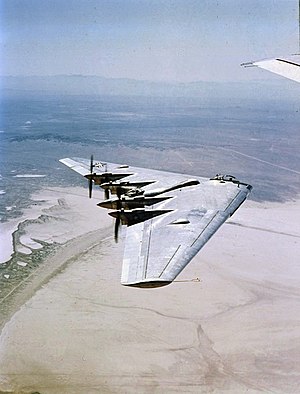Northrop YB-35
| YB-35 | |
|---|---|
 |
|
| YB-35 prototype | |
| Role | Strategic bomber |
| Manufacturer | Northrop |
| Designer | Jack Northrop |
| First flight | 25 June 1946 |
| Status | Cancelled in 1949 |
| Primary user | United States Air Force |
| Program cost | US$66 million |
| Variants | Northrop YB-49 |
The Northrop XB-35 and YB-35 were experimental heavy bomber aircraft developed by the Northrop Corporation for the United States Army Air Forces during and shortly after World War II. The airplane used the radical and potentially very efficient flying wing design, in which the tail section and fuselage are eliminated and all payload is carried in a thick wing. Only prototype and pre-production aircraft were built, although interest remained strong enough to warrant further development of the design as a jet bomber, under the designation YB-49.
The B-35 was the brainchild of Jack Northrop, who made the flying wing the focus of his work during the 1930s. During World War II, Northrop had been commissioned to develop a large wing-only, long-range bomber designated XB-35. Northrop advocated a "flying wing" as a means of reducing parasitic drag and eliminating structural weight not directly responsible for producing lift. In theory, the B-35 could carry a greater payload faster, farther, and cheaper than a conventional bomber. On 11 April 1941, the United States Army Air Corps sent out a request for a bomber that could carry 4,500 kg (10,000 lb) of bombs to a round-trip mission of 16,000 km (10,000 mi). Requested performance was a maximum speed of 720 km/h (450 mph), cruise speed of 443 km/h (275 mph), and service ceiling of 14,000 m (45,000 ft). This aircraft would be able to bomb Nazi-occupied Europe in the event that Britain fell. (This was similar to Nazi Germany's own Amerika Bomber program design competition through RLM, itself initiated in the spring of 1942.) The original April 1941 USAAC proposal was first submitted to Boeing and Consolidated Aircraft Company and led to the production of the Convair B-36. In May the contract was also extended to include Northrop, inviting them to submit a design along the lines they were already exploring.
...
Wikipedia
